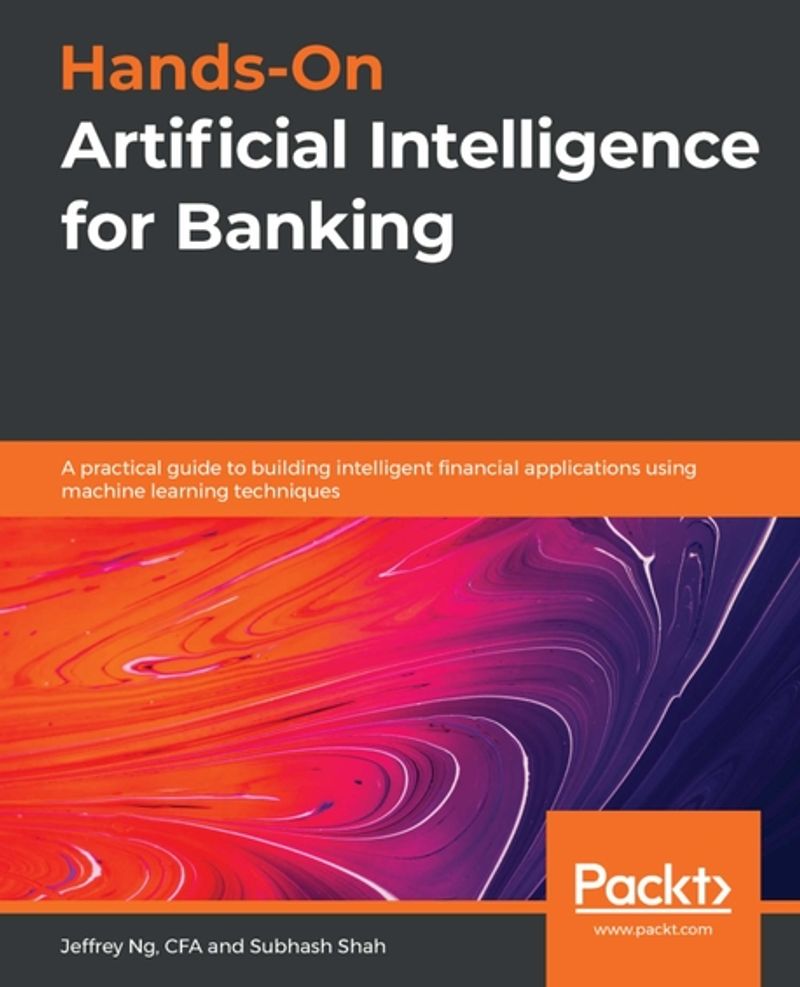Hands-On Artificial Intelligence for Banking
2020년 07월 10일 출간
- eBook 상품 정보
- 파일 정보 PDF (6.38MB)
- ISBN 9781788833967
- 지원기기 교보eBook App, PC e서재, 리더기, 웹뷰어
-
교보eBook App
듣기(TTS) 가능
TTS 란?텍스트를 음성으로 읽어주는 기술입니다.
- 전자책의 편집 상태에 따라 본문의 흐름과 다르게 텍스트를 읽을 수 있습니다.
- 이미지 형태로 제작된 전자책 (예 : ZIP 파일)은 TTS 기능을 지원하지 않습니다.
PDF 필기가능 (Android, iOS)

쿠폰적용가 18,900원
10% 할인 | 5%P 적립이 상품은 배송되지 않는 디지털 상품이며,
교보eBook앱이나 웹뷰어에서 바로 이용가능합니다.
카드&결제 혜택
- 5만원 이상 구매 시 추가 2,000P
- 3만원 이상 구매 시, 등급별 2~4% 추가 최대 416P
- 리뷰 작성 시, e교환권 추가 최대 200원
작품소개
이 상품이 속한 분야
- Automate commercial bank pricing with reinforcement learning
- Perform technical analysis using convolutional layers in Keras
- Use natural language processing (NLP) for predicting market responses and visualizing them using graph databases
- Deploy a robot advisor to manage your personal finances via Open Bank API
- Sense market needs using sentiment analysis for algorithmic marketing
- Explore AI adoption in banking using practical examples
- Understand how to obtain financial data from commercial, open, and internal sources
▶Key Features
- Understand how to obtain financial data via Quandl or internal systems
- Automate commercial banking using artificial intelligence and Python programs
- Implement various artificial intelligence models to make personal banking easy
▶Who This Book Is For
This is one of the most useful artificial intelligence books for machine learning engineers, data engineers, and data scientists working in the finance industry who are looking to implement AI in their business applications. The book will also help entrepreneurs, venture capitalists, investment bankers, and wealth managers who want to understand the importance of AI in finance and banking and how it can help them solve different problems related to these domains. Prior experience in the financial markets or banking domain, and working knowledge of the Python programming language are a must.
▷ Section 1: Quick Review of AI in the Finance Industry
1. The Importance of AI in Banking
▷ Section 2: Machine Learning Algorithms and Hands-on Examples
2. Time Series Analysis
3. Using Features and Reinforcement Learning to Automate Bank Financing
4. Mechanizing Capital Market Decisions
5. Predicting the Future of Investment Bankers
6. Automated Portfolio Management Using Treynor-Black Model and ResNet
7. Sensing Market Sentiment for Algorithmic Marketing at Sell Side
8. Building Personal Wealth Advisers with Bank APIs
9. Mass Customization of Client Lifetime Wealth
10. Real-World Considerations
▶What this book covers
- Chapter 1, The Importance of AI in Banking, explains what AI is and discusses its applications in banking. This chapter also provides a detailed introduction to banking as a sector, the complexity of banking processes, and diversification in banking functions.
- Chapter 2, Time Series Analysis, covers time series analysis. This chapter explains time series analysis in detail with examples and explains how the Machine-to-Machine (M2M) concept can be helpful in the implementation of time series analysis.
- Chapter 3, Using Features and Reinforcement Learning to Automate Bank Financing, covers reinforcement learning. It also covers different AI modeling techniques using examples, as well as the business functions of the bank in the context of examples.
- Chapter 4, Mechanizing Capital Market Decisions, discusses the basic financial and capital market concepts. We will look at how AI can help us optimize the best capital structure by running risk models and generating sales forecasts using macro-economic data. The chapter also covers important machine learning modeling techniques such as learning optimization and linear regression.
- Chapter 5, Predicting the Future of Investment Bankers, introduces AI techniques followed by auto-syndication for new issues. We will see how capital can be obtained from interested investors. In the latter section of the chapter, we will cover the case of identifying acquirers and targets―a process that requires science to pick the ones that need banking services.
- Chapter 6, Automated Portfolio Management Using Treynor-Black Model and ResNet, focuses on the dynamics of investors. The chapter discusses portfolio management techniques and explains how to combine them with AI to automate decision-making when buying assets.
- Chapter 7, Sensing Market Sentiment for Algorithmic Marketing at Sell Side, focuses on the sell side of the financial market. The chapter provides details about securities firms and investment banks. This chapter also discusses sentiment analysis and covers an example of building a network using Neo4j.
- Chapter 8, Building Personal Wealth Advisers with Bank APIs, focuses on consumer banking. The chapter explains the requirements of managing the digital data of customers. The chapter also explains how to access open bank APIs and explains document layout analysis.
- Chapter 9, Mass Customization of Client Lifetime Wealth, explains how to combine data from the survey for personal data analysis. The chapter also discusses Neo4j, which is a graph database. In this chapter, we will build a chatbot to serve customers 24/7. We will also look at an example entailing the prediction of customer responses using natural language processing, Neo4j, and cipher languages to manipulate data from the Neo4j database.
- Chapter 10, Real World Considerations, serves as a summary of the AI modeling techniques covered in the previous chapters. The chapter also shows where to look for further knowledge of the domain.
▶ Preface
Remodeling your outlook on banking begins with keeping up to date with the latest and most effective approaches, such as artificial intelligence (AI). Hands-On Artificial Intelligence for Banking is a practical guide that will help you advance in your career in the banking domain. The book will demonstrate AI implementation to make your banking services smoother, more cost-efficient, and accessible to clients, focusing on both the client- and server-side uses of AI.
You’ll begin by understanding the importance of artificial intelligence, while also gaining insights into the recent AI revolution in the banking industry. Next, you’ll get hands-on machine learning experience, exploring how to use time series analysis and reinforcement learning to automate client procurements and banking and finance decisions. After this, you’ll progress to learning about mechanizing capital market decisions, using automated portfolio management systems and predicting the future of investment banking. In addition to this, you’ll explore concepts such as building personal wealth advisors and mass customization of client lifetime wealth. Finally, you’ll get to grips with some real-world AI considerations in the field of banking.
By the end of this book, you’ll be equipped with the skills you need to navigate the finance domain by leveraging the power of AI.
작가정보
저자(글) Jeffrey Ng
Jeffrey Ng, CFA, works at Ping An OneConnect Bank (Hong Kong) Limited as Head of FinTech Solutions. His mandate is to advance the use of AI in banking and financial ecosystems. Prior to this, he headed up the data lab of BNP Paribas Asia Pacific, which constructed an AI and data analytics solution for business, and was the vice-chair of the French Chamber of Commerce's FinTech Committee in Hong Kong. In 2010, as one of the pioneers in applying client analytics to investment banking, he built the analytics team for the bank. He has undertaken AI projects in retail and commercial banks with PwC Consulting and GE Money. He graduated from Hong Kong Polytechnic University in computing and management and holds an MBA in finance from the Chinese University of Hong Kong.
저자(글) Subhash Shah
Subhash Shah is an experienced solution architect. With 14 years of experience in software development, he works as an independent technical consultant now. He is an advocate of open source development and its utilization in solving critical business problems. His interests include Microservices architecture, Enterprise solutions, Machine Learning, Integrations and Databases. He is an admirer of quality code and test-driven development (TDD). His technical skills include translating business requirements into scalable architecture and designing sustainable solutions. He is a co-author of Hands-On High Performance with Spring 5, Hands-On AI for Banking and MySQL 8 Administrator's Guide. He has also been a technical reviewer for other books.
저자(글) CFA
이 상품의 총서
Klover리뷰 (0)
- - e교환권은 적립일로부터 180일 동안 사용 가능합니다.
- - 리워드는 5,000원 이상 eBook, 오디오북, 동영상에 한해 다운로드 완료 후 리뷰 작성 시 익일 제공됩니다. (2024년 9월 30일부터 적용)
- - 리워드는 한 상품에 최초 1회만 제공됩니다.
- - sam 이용권 구매 상품 / 선물받은 eBook은 리워드 대상에서 제외됩니다.
- 도서나 타인에 대해 근거 없이 비방을 하거나 타인의 명예를 훼손할 수 있는 리뷰
- 도서와 무관한 내용의 리뷰
- 인신공격이나 욕설, 비속어, 혐오 발언이 개재된 리뷰
- 의성어나 의태어 등 내용의 의미가 없는 리뷰
구매 후 리뷰 작성 시, e교환권 100원 적립
문장수집
- 구매 후 90일 이내에 문장 수집 등록 시 e교환권 100원을 적립해 드립니다.
- e교환권은 적립일로부터 180일 동안 사용 가능합니다.
- 리워드는 5,000원 이상 eBook에 한해 다운로드 완료 후 문장수집 등록 시 제공됩니다. (2024년 9월 30일부터 적용)
- 리워드는 한 상품에 최초 1회만 제공됩니다.
- sam 이용권 구매 상품 / 선물받은 eBook / 오디오북·동영상 상품/주문취소/환불 시 리워드 대상에서 제외됩니다.
구매 후 문장수집 작성 시, e교환권 100원 적립
신규가입 혜택 지급이 완료 되었습니다.
바로 사용 가능한 교보e캐시 1,000원 (유효기간 7일)
지금 바로 교보eBook의 다양한 콘텐츠를 이용해 보세요!

- 구매 후 90일 이내 작성 시, e교환권 100원 (최초1회)
- 리워드 제외 상품 : 마이 > 라이브러리 > Klover리뷰 > 리워드 안내 참고
- 콘텐츠 다운로드 또는 바로보기 완료 후 리뷰 작성 시 익일 제공
가장 와 닿는 하나의 키워드를 선택해주세요.
총 5MB 이하로 jpg,jpeg,png 파일만 업로드 가능합니다.
신고 사유를 선택해주세요.
신고 내용은 이용약관 및 정책에 의해 처리됩니다.
허위 신고일 경우, 신고자의 서비스 활동이 제한될 수
있으니 유의하시어 신중하게 신고해주세요.
이 글을 작성한 작성자의 모든 글은 블라인드 처리 됩니다.
구매 후 90일 이내 작성 시, e교환권 100원 적립
eBook 문장수집은 웹에서 직접 타이핑 가능하나, 모바일 앱에서 도서를 열람하여 문장을 드래그하시면 직접 타이핑 하실 필요 없이 보다 편하게 남길 수 있습니다.
차감하실 sam이용권을 선택하세요.
차감하실 sam이용권을 선택하세요.
선물하실 sam이용권을 선택하세요.
-
보유 권수 / 선물할 권수0권 / 1권
-
받는사람 이름받는사람 휴대전화
- 구매한 이용권의 대한 잔여권수를 선물할 수 있습니다.
- 열람권은 1인당 1권씩 선물 가능합니다.
- 선물한 열람권이 ‘미등록’ 상태일 경우에만 ‘열람권 선물내역’화면에서 선물취소 가능합니다.
- 선물한 열람권의 등록유효기간은 14일 입니다.
(상대방이 기한내에 등록하지 않을 경우 소멸됩니다.) - 무제한 이용권일 경우 열람권 선물이 불가합니다.
첫 구매 시 교보e캐시 지급해 드립니다.

- 첫 구매 후 3일 이내 다운로드 시 익일 자동 지급
- 한 ID당 최초 1회 지급 / sam 이용권 제외
- 구글바이액션을 통해 교보eBook 구매 이력이 없는 회원 대상
- 교보e캐시 1,000원 지급 (유효기간 지급일로부터 7일)





